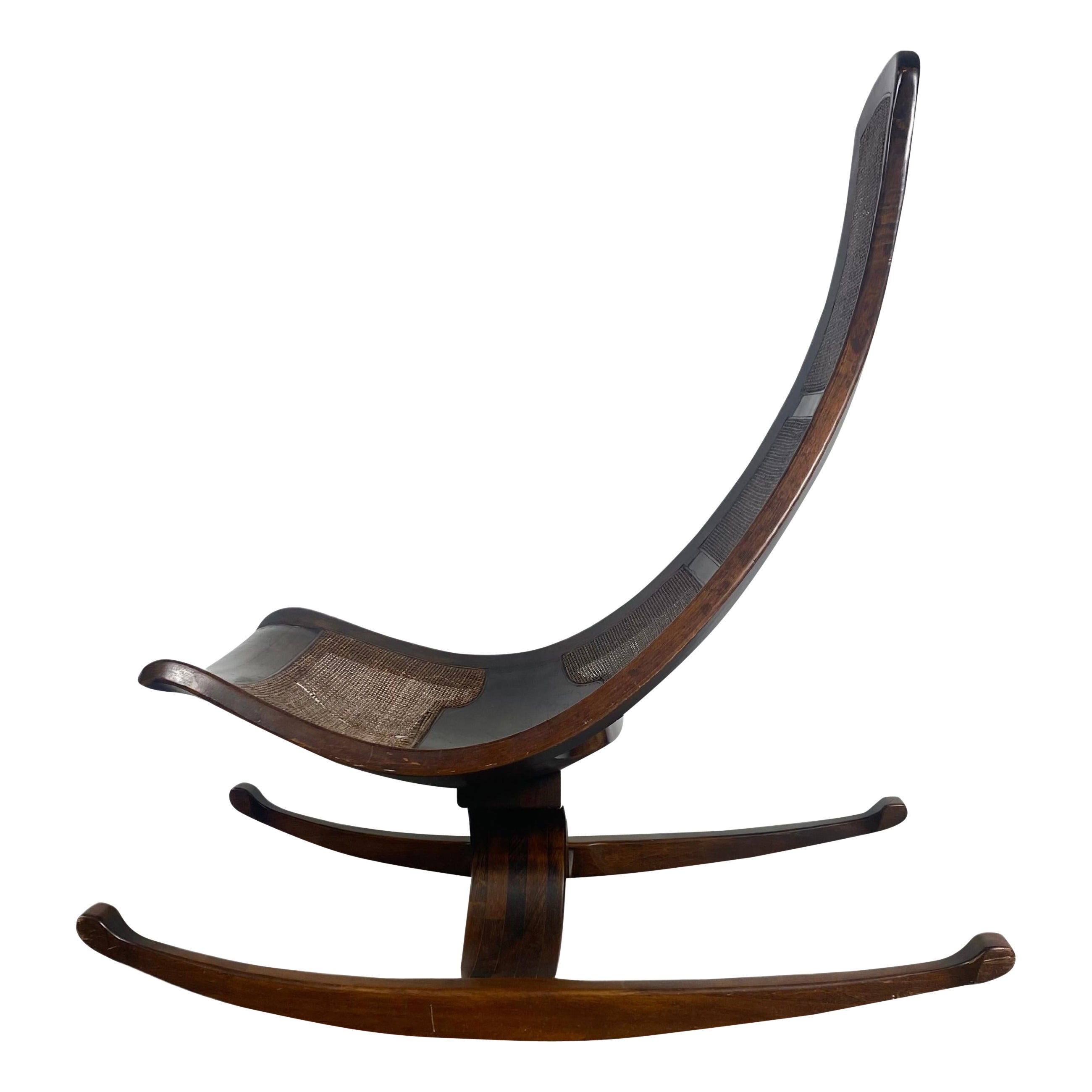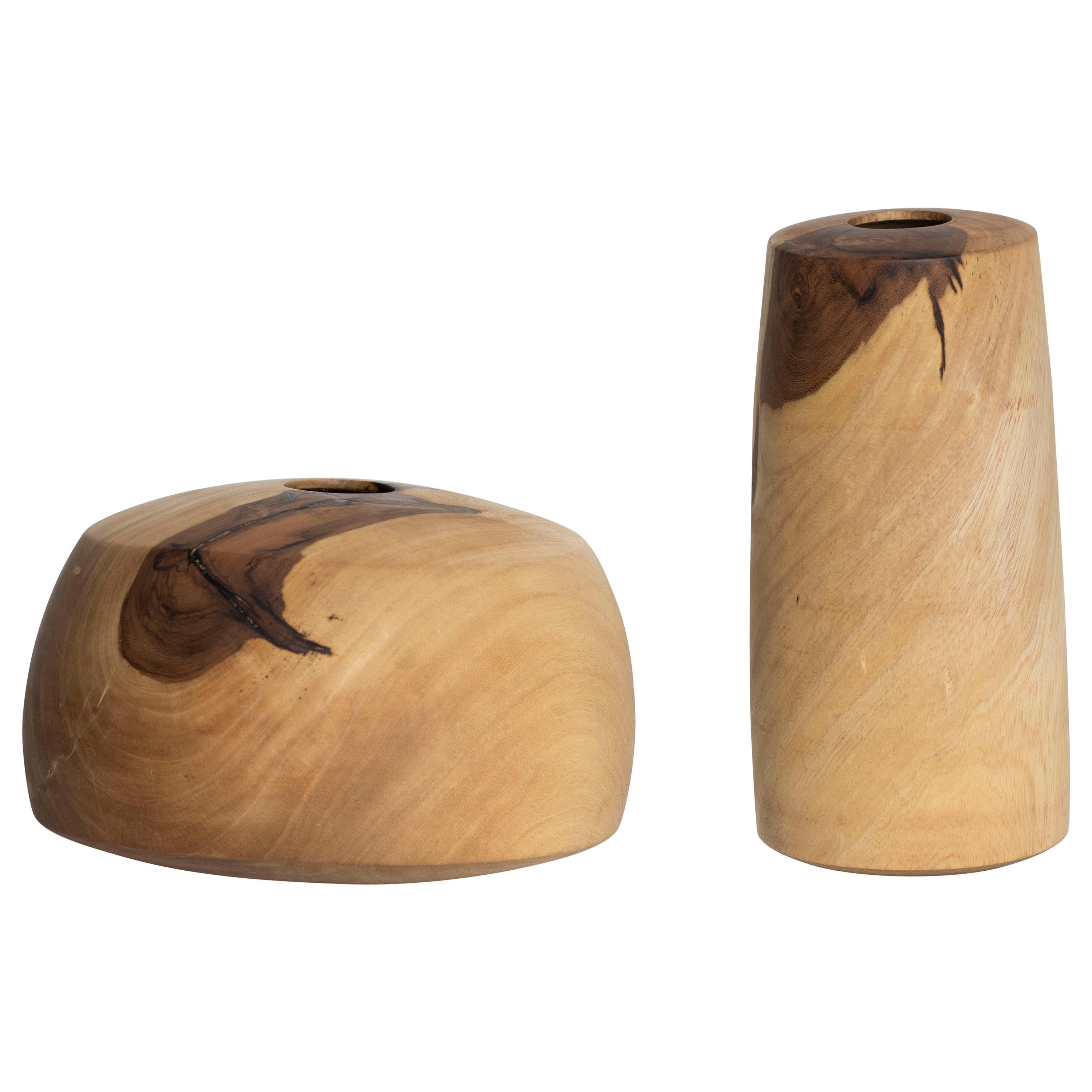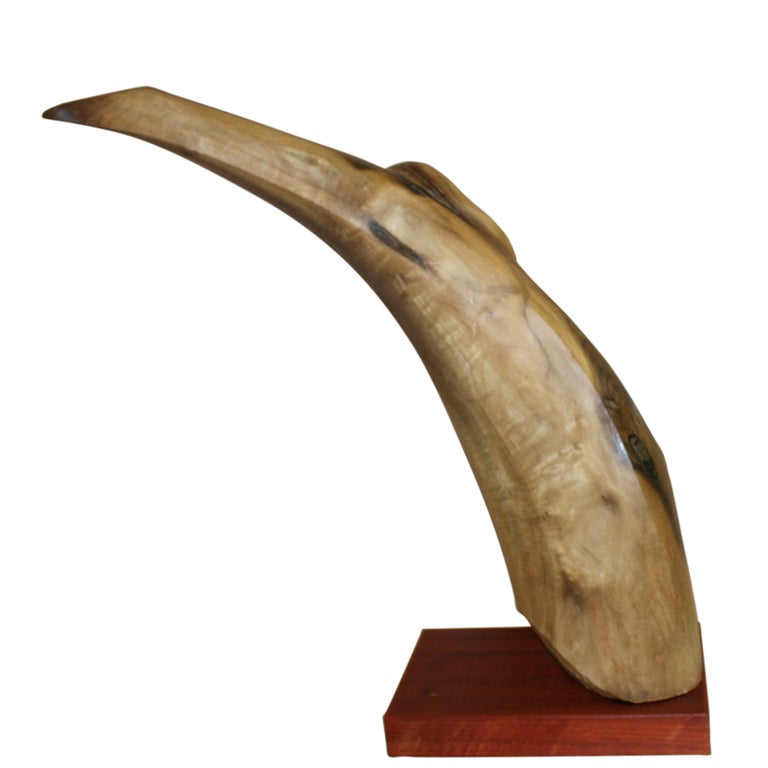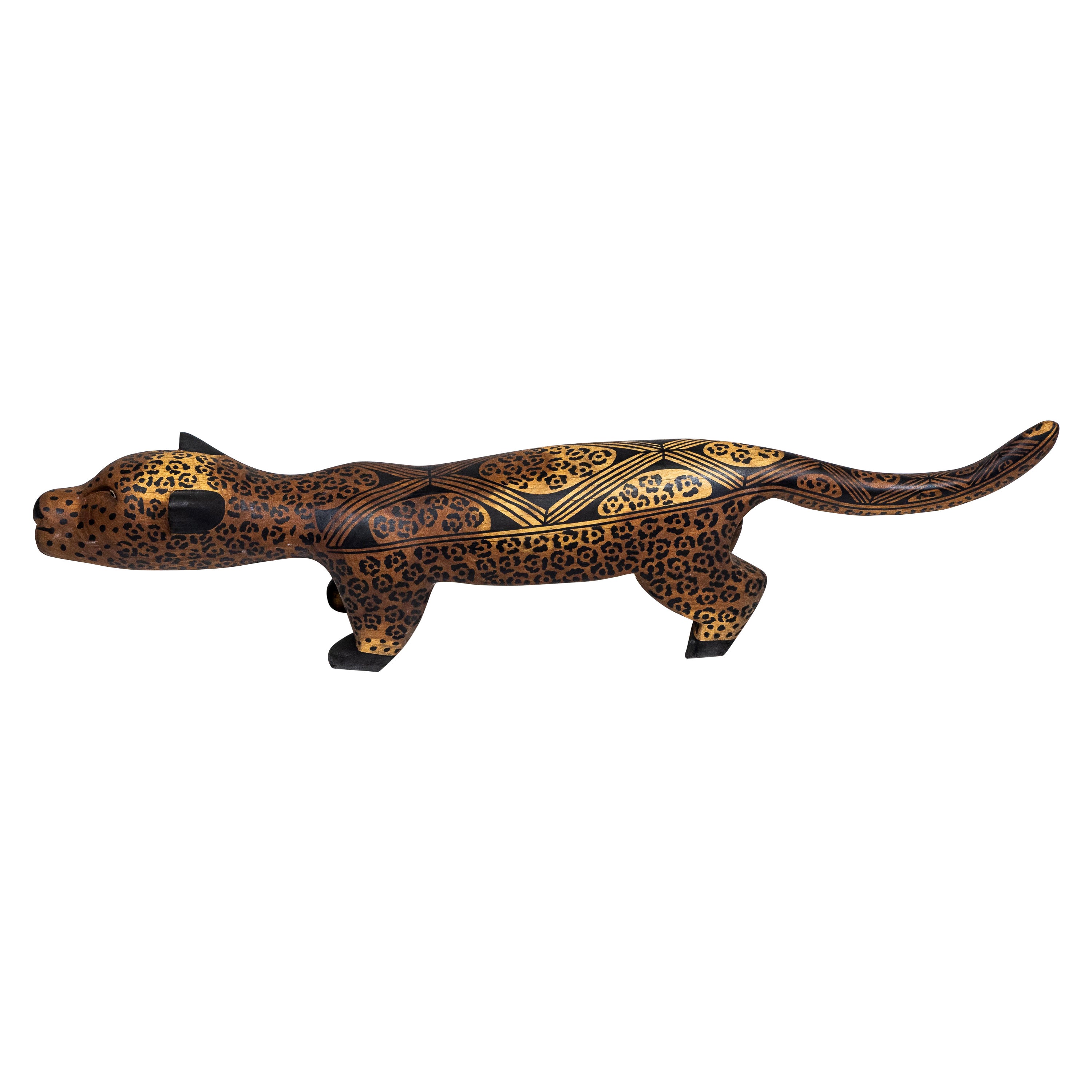Items Similar to Wauja/ Turuza. Monkey Sculpture, 2021, Brazilian exotic wood
Want more images or videos?
Request additional images or videos from the seller
1 of 5
Wauja/ Turuza. Monkey Sculpture, 2021, Brazilian exotic wood
About the Item
La sculpture intitulée "Wauja/Turuza. Singe, 2021" est une œuvre d'art réalisée par l'artiste indigène Turuza, appartenant à l'ethnie Wauja du Haut-Xingu, au Brésil. Fabriquée à partir de bois exotique brésilien, plus précisément de Piranheira, cette pièce artistique est également agrémentée de pigments naturels à base de "jenipapo" et de coquilles d'escargot.
À l'origine, cette sculpture était utilisée comme objet symbolique au sein de la communauté indigène Wauja. Turuza, en tant qu'artiste contemporain, a créé cette œuvre en utilisant des techniques et des matériaux traditionnels. La sculpture a été façonnée dans une pièce massive de bois, et ses motifs peints à la main lui confèrent un aspect à la fois graphique et sculptural.
En plus de son caractère artistique, cette œuvre s'engage socialement. En effet, 15% du prix de vente de la sculpture sera reversé à une association qui œuvre pour la protection de la région du parc du Xingu, ainsi que pour la préservation du mode de vie de la population autochtone qui y réside. Ainsi, l'achat de cette sculpture contribue directement à la préservation de l'écosystème local et au soutien des communautés indigènes de la région.
- Dimensions:Height: 16 in (40.64 cm)Width: 59 in (149.86 cm)Depth: 13 in (33.02 cm)
- Style:Folk Art (In the Style Of)
- Materials and Techniques:
- Place of Origin:
- Period:
- Date of Manufacture:2021
- Production Type:New & Custom(One of a Kind)
- Estimated Production Time:Available Now
- Condition:
- Seller Location:PARIS, FR
- Reference Number:1stDibs: LU6408237258202
About the Seller
No Reviews Yet
Vetted Seller
These experienced sellers undergo a comprehensive evaluation by our team of in-house experts.
Established in 2021
1stDibs seller since 2022
11 sales on 1stDibs
Typical response time: <1 hour
- ShippingRetrieving quote...Ships From: Saint-Ouen, France
- Return PolicyThis item cannot be returned.
More From This SellerView All
- Bench / Sculpture "Onça Pintada", by Indigenous Community Wauja, 2020sLocated in PARIS, FROriginally used as a symbolic object by the indigenous ethnic groups of Upper Xingu, this bench is a contemporary creation made using traditional techniques and materials. Carved fro...Category
2010s Brazilian Primitive Animal Sculptures
MaterialsWood, Hardwood
- Wauja, Céramique Indigène Zoomorphe, "Tatu", 2020Located in PARIS, FRCette céramique est une création contemporaine de la tribu Wauja situé au Haut Xingu/ Brésil. Réalisée selon les méthodes traditionnelles avec des matières premières naturelles, son ...Category
2010s Brazilian Arts and Crafts Animal Sculptures
MaterialsCeramic
- Abraham Palatnik, Fish, Kinetic Sculpture in Acrylic Resin, Brazil, C. 1960By Abraham PalatnikLocated in PARIS, FRAbraham Palatnik (1928-2020) Sculpture "Fish", c. 1960 Polyester resin and pigment in black and white. Signed PAL Kinetic art - Beautiful and rare polyester resin sculpture from the HOME AND FARM collection representing a goose. This sculpture is part of the series of animal sculptures that Abraham Palatnik made from the 1960s, in small format, they are small jewels of kinetic art, a movement of which he was one of the pioneers. "Born in Natal, Rio Grande do Norte, Brazil, in 1928 to a family of Russian Jews, Palatnik moved with his family to Tel Aviv (then Palestine) when he was four years old. He attended Montefiori Technical School, where he specialized in internal combustion engines, and studied art under the tutelage of the painter Haaron Avni and the sculptor Sternshus at the Municipal Institute of Art. When he returned to Brazil in 1948, his output consisted mainly of figurative and landscape paintings and charcoal drawings. However, his encounters with the complex works made by schizophrenic patients at the Pedro II Psychiatric Hospital, where he taught painting workshops alongside Almir Mavignier...Category
Mid-20th Century Brazilian Kinetic Animal Sculptures
MaterialsAcrylic, Paint
- Abraham Palatnik, Goose, Kinetic Sculpture in Acrylic Resin, Brazil, C. 1960By Abraham PalatnikLocated in PARIS, FRAbraham Palatnik (1928-2020) Sculpture "Canard", c. 1960 Polyester resin and pigment in black and white. Kinetic art - Beautiful and rare polyester resin sculpture from the HOME AND FARM collection representing an goose. This sculpture is part of the series of animal sculptures that Abraham Palatnik made from the 1960s, in small format, they are small jewels of kinetic art, a movement of which he was one of the pioneers. "Born in Natal, Rio Grande do Norte, Brazil, in 1928 to a family of Russian Jews, Palatnik moved with his family to Tel Aviv (then Palestine) when he was four years old. He attended Montefiori Technical School, where he specialized in internal combustion engines, and studied art under the tutelage of the painter Haaron Avni and the sculptor Sternshus at the Municipal Institute of Art. When he returned to Brazil in 1948, his output consisted mainly of figurative and landscape paintings and charcoal drawings. However, his encounters with the complex works made by schizophrenic patients at the Pedro II Psychiatric Hospital, where he taught painting workshops alongside Almir Mavignier...Category
Mid-20th Century Brazilian Kinetic Animal Sculptures
MaterialsAcrylic, Paint
- Abraham Palatnik, Elephant, Kinetic Sculpture in Acrylic Resin, Brazil, C. 1960By Abraham PalatnikLocated in PARIS, FRAbraham Palatnik (1928-2020) Sculpture "Elephant", c. 1960 Vintage label (made in Brazil). Polyester resin and pigment in black. Kinetic art - Beautiful and rare polyester resin sculpture from the HOME AND FARM collection representing an elephant signed in the base. This sculpture is part of the series of animal sculptures that Abraham Palatnik made from the 1960s, in small format, they are small jewels of kinetic art, a movement of which he was one of the pioneers. "Born in Natal, Rio Grande do Norte, Brazil, in 1928 to a family of Russian Jews, Palatnik moved with his family to Tel Aviv (then Palestine) when he was four years old. He attended Montefiori Technical School, where he specialized in internal combustion engines, and studied art under the tutelage of the painter Haaron Avni and the sculptor Sternshus at the Municipal Institute of Art. When he returned to Brazil in 1948, his output consisted mainly of figurative and landscape paintings and charcoal drawings. However, his encounters with the complex works made by schizophrenic patients at the Pedro II Psychiatric Hospital, where he taught painting workshops alongside Almir Mavignier and Ivan Serpa, caused him to abandon his early approach to traditional image-making: “I decided to start all over from scratch,” Palatnik said. “The discipline from the school, the studio, was no longer of any use.” Freed from the perceived restrictions of his training, Palatnik became closely associated with Grupo Frente, a movement started by Serpa and rooted in geometric abstraction. He used his knowledge of engineering and mechanics as well as his interest in natural forces to build his first Kinechromatic work. Titled Azul e roxo em seu primeiro movimento (Blue and Purple in First Movement), 1949, the piece debuted at the inaugural São Paulo Bienal in 1951. “In reality, it was luck that got me into the biennial,” Palatnik said in a 1986 interview. “At first, my machine was rejected, because it wasn’t a painting, a sculpture, a drawing, or a print.” The piece, which eventually gained entry, shocked the biennial’s grand prize jury, who gave Palatnik an honorable mention, calling his work an “important manifestation of modern art.” By 1969, he had participated in seven more editions of the international exhibition. Palatnik would also present work in the 1964 Venice Biennale, the 1966 Biennial of Córdoba, and the 1997 and 2005 editions of the Mercosul Biennial. His art was featured in significant exhibitions on kinetic art, including “Mouvement 2” (1964) at Denise René gallery in Paris; “Lumière, Mouvement et Optique” (1965) at the Brussels Palace of Fine Arts; “Kinetic Art” (1966) at the Museum of San Francisco; and, more recently, “Delirious: Art at the Limits of Reason, 1950–1980” (2017) at the Metropolitan Museum of Art in New York and “The Other Trans-Atlantic: Kinetic & Op Art in Central & Eastern Europe and Latin America 1950s–1970s” (2018) at Sesc Pinheiros in São Paulo. A major retrospective, “Abraham Palatnik—The Reinvention of Painting,” was staged at several venues across Brazil, including the Centro Cultural Banco do Brasil Rio de Janeiro (2017); the Fundação Iberê...Category
Mid-20th Century Brazilian Kinetic Animal Sculptures
MaterialsAcrylic, Paint
- Abraham Palatnik, Bird, Kinetic Sculpture in Acrylic Resin, Brazil, circa 1960By Abraham PalatnikLocated in PARIS, FRAbraham Palatnik (1928-2020) Bird Sculpture, circa 1960 Polyester resin and pigments. Measures: (21.5 x 9.5 x 2.5 cm) This Polyester resin sculpture representing a bird, in the colors yellow and black It is part of the series of animal sculptures that Abraham Palatnik made from the 1960s, in small format, they are small jewels of kinetic art, a movement that Palatnik was one of the pioneers. "Born in Natal, Rio Grande do Norte, Brazil, in 1928 to a family of Russian Jews, Palatnik moved with his family to Tel Aviv (then Palestine) when he was four years old. He attended Montefiori Technical School, where he specialized in internal combustion engines, and studied art under the tutelage of the painter Haaron Avni and the sculptor Sternshus at the Municipal Institute of Art. When he returned to Brazil in 1948, his output consisted mainly of figurative and landscape paintings and charcoal drawings. However, his encounters with the complex works made by schizophrenic patients at the Pedro II Psychiatric Hospital, where he taught painting workshops alongside Almir Mavignier...Category
Mid-20th Century Brazilian Kinetic Animal Sculptures
MaterialsAcrylic
You May Also Like
- Cane and Exotic Wood Brazilian Rocking ChairBy Joaquim TenreiroLocated in Buffalo, NYSculptural Brazilian rocking chair in the style of Joaquim Tenriero. Amazing quality and design. Original cane seat in need of restoration. (see photo). Hand delivery avail to New Yo...Category
Vintage 1970s Brazilian Mid-Century Modern Rocking Chairs
MaterialsCane, Wood
- Wood Sculpture Brazilian DesignBy Leonardo SokoloviczLocated in New York, NYDelicate woodcraft work of Leonardo Sokolowicz.Category
2010s Brazilian Abstract Sculptures
MaterialsWood
- Elegant Exotic 1960s Wood SculptureLocated in Palm Springs, CAThis sculpture was purchased out of estate with a group of exotic wood sculptures from the 1960s. The rest we have already posted but this one needed a new base which we had crafted ...Category
Vintage 1960s American Sculptures
MaterialsWood
- Art Deco Monkeys Sculpture in WoodLocated in Tilburg, NLBeautifully carved Art Deco figurine of two monkeys in tropical wood. First half of the 20th century. An adult monkey and a young monkey are seen in a dynamic and lifelike situation. This is a beautifully sculpted statue...Category
Early 20th Century Unknown Art Deco Animal Sculptures
MaterialsWood
- ceramic monkey sculptureLocated in Buenos Aires, Argentinaceramic monkey sculpture Wise monkey model unusual figure of a monkey sitting on books and looking in the mirror hand painted excellent condition circa 1950 origin Germany glazed cer...Category
Vintage 1950s German Mid-Century Modern Animal Sculptures
MaterialsEnamel
- Massive Hand Carved Monkey Pod Exotic Hardwood Lovers Embrace Coffee TableLocated in Chattanooga, TNMasterfully hand carved from what must have been a colossal solid piece of monkey pod hardwood. This nude figural sculpture weighs around 250 lbs. Although ...Category
Late 20th Century Southeast Asian Folk Art Coffee and Cocktail Tables
MaterialsGlass, Hardwood
Recently Viewed
View AllMore Ways To Browse
Mother Giraffe
Modernist Bull Sculpture
Bronze Mountain Goat
Concrete Sheep
Brass Heron Crane
Omersa Horse
Call Bell Button
Eagle Perfume Lamp
Lalique Kazak Horse
Hagenauer Sculptures For Sale
Nacre Trinket
Fish Coat
Franz Bergmann Miniature
Viking Figure Teak
Brass Giraffe Statues
Car Mascot Max Le Verrier
Cast Iron Cats Hubley
Edgar Brandt Serpent





